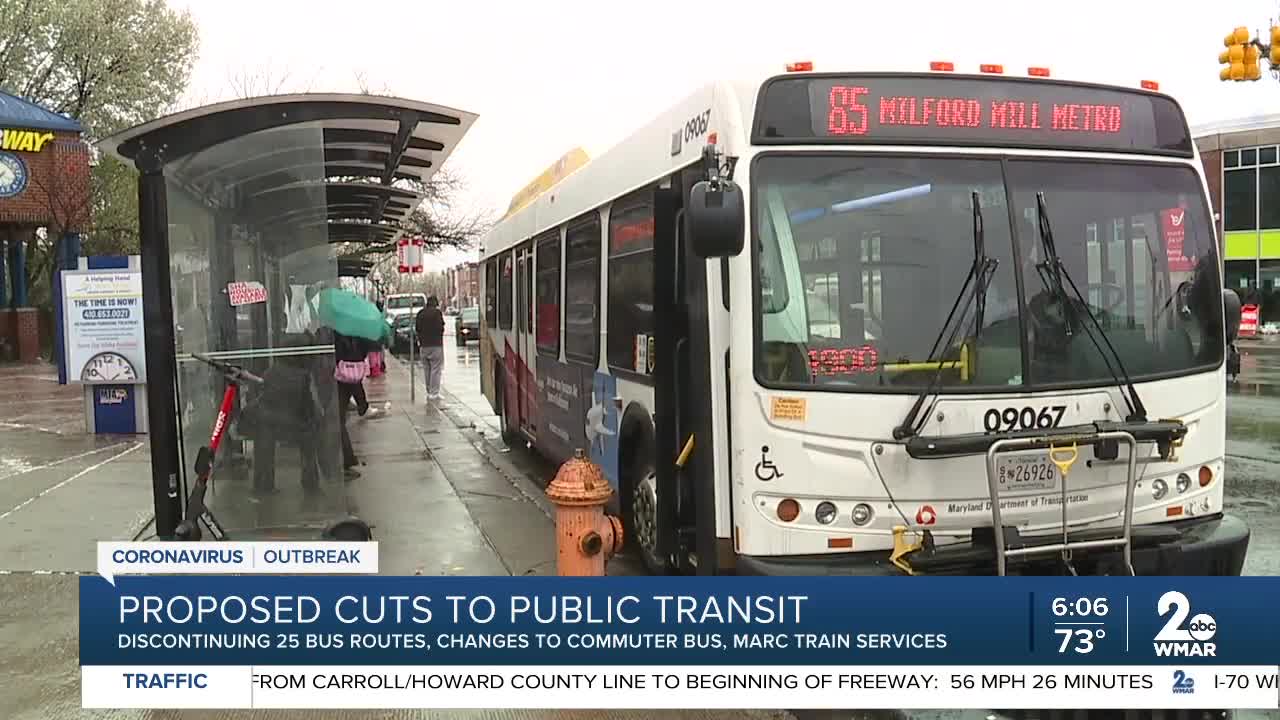BALTIMORE — The Maryland Transit Administration is proposing service changes due to the financial impact related to the coronavirus pandemic.
The proposal would affect approximately 3.6% of riders and would go into effect on January 3, 2021.
Additionally, proposed local bus changes include adding, reducing, or discontinuing service.
10 virtual public hearings for Local Bus will be held between Oct 5 and 16 about the proposed changes as part of a 30-day public review and comment period that ends November 15.
The proposed changes include:
LOCAL BUS
The MTA said Local Bus route realignments would result in an overall service reduction of about 20%, affecting routes that have lower ridership and/or overlapping service with other routes.
The MTA said that of the approximately 3.6% of riders who would be affected, more than half of those riders would still have access to transit within a quarter mile.
For Local Bus, a summary of proposed changes is shown below:
Additional Service:
- Increase frequency on LocalLinks 56 and 78 which will expand the Frequent Transit Network to a total of 20 routes and provide a greater level of service to Grace Medical Center (formerly Bon Secours Hospital) and Johns Hopkins Hospital.
- Improve service on LocalLink 69 which operates to MedStar Harbor Hospital and the University of Maryland Baltimore Washington Medical Center.
Reduced Service:
- Reduce service frequency on 11 LocalLink routes with lower ridership including:
- LocalLinks 28, 29, 31, 33, 37, 62, 67, 76, 75, 77, 83 and 87.
Discontinued Service:
- Discontinue 25 routes including:
- All nine Express Bus routes (103, 104, 105, 115, 120, 150, 154, 160, and 164) which operate limited-stop service from the suburbs to Baltimore City, and
- LocalLinks 21, 34, 38, 51, 52, 53, 57, 59, 70, 71, 73, 81, 82, 91, 92 and 95 due to lower ridership or access available on another route.
Modified Routes:
- Modify alignments to 13 routes.
- Of the 13 modified routes, the CityLinks Red, Silver and Lime, and the LocalLinks 26, 36, 63 and 94 will receive additional service to cover gaps in access.
- Adjust the alignment of the LocalLink 93 to better provide access to jobs along the York Road corridor.
COMMUTER BUS
For Commuter Bus, a summary of proposed changes is shown below. Additional details on this proposed service change will be announced in the fall.
Discontinued Service:
- Two routes are proposed to be discontinued due to low ridership:
- Route 210 Kent Island and Annapolis to Downtown Baltimore, and
- Route 215 Downtown Baltimore to Annapolis.
Reduced Service:
- Reduce service frequency on 20 routes where ridership is low while retaining overall span of service.
- Routes include: 201, 203, 204, 220, 230, 240, 260, 305, 315, 320, 325, 345, 410, 411, 420, 505, 705, 715, 810, and 840.
MARC
For MARC, a summary of proposed changes is shown below. Additional details on this proposed service change will be announced in the fall.
Discontinued Service:
- Penn Line service between Union Station and Perryville:
- Train 520 to terminate at Baltimore Penn Station Monday through Thursday and operate to Perryville on Fridays
- Train 548 to terminate at Baltimore Penn Station Monday through Friday
- Train 537 (afternoon)
- Penn Line northbound service from Union Station:
- Trains 410 and 418 (morning)
- Penn Line southbound service from Penn Station
- Train 423 (morning)
- Camden Line service:
- Eastbound from Union Station: Trains 844 (morning) and 848 (afternoon)
- Westbound from Dorsey Station: Train 855 (afternoon)
Riders can visit www.mta.maryland.gov/winter2021 for a complete list of service modifications and public hearing dates and locations.
Top officials from Baltimore County, Baltimore City, Howard County, and Anne Arundel County joined together to issue the following statement on major cuts to the Maryland Transit Administration:
“In a press release this afternoon, Governor Hogan’s administration announced significant cuts to the Maryland Transit Administration.This is a disappointing blow to the entire Baltimore metropolitan region and the many students, essential workers, and families who rely on public transportation each day. Making cuts to an already underfunded system means students will struggle to get to and from school, even as the Governor advocates for a return to in-person learning as soon as possible. It means the essential workers, from cleaning staff to doctors and nurses, may not be able to reliably get to hospitals and medical facilities for their vital work during a public health emergency. It means more strain on our transit workers, who have been on the frontlines contending with COVID-19 in order to keep our region moving through these uncertain times. We understand the deep ways COVID-19 has already and will continue to impact our local economies, we need to ensure that these cuts don’t disproportionately impact the most vulnerable members of our regional population. Making operational and capital budget cuts with no guarantee service will ever be restored is a significant concern. When workers at major regional employers rely on MTA to get to and from work, these cuts to service will further harm our local economies and businesses. As leaders within the region, we will be evaluating these proposed reductions and service changes carefully over the coming days and weeks and will be prepared to offer detailed comments to the MTA in early October. We need more information from MDOT and regional employers to help determine the full impact of these cuts to service on our local economies and businesses. We call on all residents in the region to join their elected leaders in voicing opposition to these cuts during MTA's public comment period. Make no mistake about it: This decision will disproportionately impact our poor, Black and Brown residents, especially those living in historically-disinvested neighborhoods. Particularly during a public health emergency that continues to have devastating impacts, we should not seek to balance the budget on the backs of the most vulnerable.”


